

Latest Tweets / Twitter. Anti-racism resources for white people. Measures of Effective Teaching Project Releases Final Research Report - Bill & Melinda Gates Foundation. Findings Help Inform Design andImplementation of High-Quality Feedback and Evaluation Systems PHOENIX (January 8, 2013) – The Measures of Effective Teaching (MET) project, a three-year study designed to determine how to best identify and promote great teaching, today released its third and final research report.
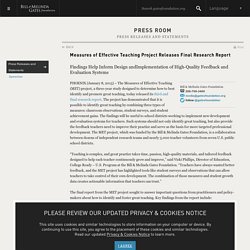
The project has demonstrated that it is possible to identify great teaching by combining three types of measures: classroom observations, student surveys, and student achievement gains. The findings will be useful to school districts working to implement new development and evaluation systems for teachers. Such systems should not only identify great teaching, but also provide the feedback teachers need to improve their practice and serve as the basis for more targeted professional development. Instructional practices and classroom interactions of high and low expectation teachers in China.
Desirable Difficulties & how to have an impact on learning from research by Bjork. Please RT □□ Access our research-informed resources by registering for ImpactPlus here. @mn_ester @inSPIRE_FE @joannabarrett12 For this journal you can co produce with a trainee or early career teacher. But yes - other journals. For FE @ARPCEresearch or @Post16Educator could be good starting points. @JournalPrism too. Home - inSPIRE FE. Dual Coding: What’s the deal with all those icons? Before you read this, you may want to watch my talk for researchEd home where I outline the major principles of Dual Coding Theory and its expression in the Multimedia Effect.
In due course I will publish some FAQs that I received. Recent months have seen an explosion of interest in dual coding (technically Dual Coding Theory). Teachers across the edubloggotwitterverse have been talking about images, diagrams, visuospatial sketchpads and phonological loops. Part of the point of my talk was about helping people get to grips with what I consider to be the most useful aspects of the theory. Part of the talk was also about heading off lethal mutations: about trying to stop good ideas turned weird, useless or actively harmful. What’s the deal with those infernal icons?
Learning to teach: mentoring and tutoring student teachers - OpenLearn - Open University - LTT_2. HOW TO ENGAGE IN PSEUDOSCIENCE WITH REAL DATA: A CRITICISM OF JOHN HATTIE’S ARGUMENTS IN VISIBLE LEARNING FROM THE PERSPECTIVE OF A STATISTICIAN. How to engage in pseudoscience with real data: A criticism of John Hattie’s arguments in Visible Learning from the perspective of a statistician The work of John Hattie on education contains, seemingly, the most comprehensive synthesis of existing research in the field.
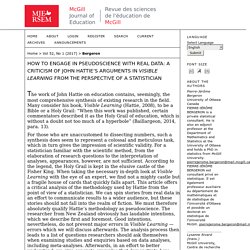
Many consider his book, Visible Learning (Hattie, 2008), to be a Bible or a Holy Grail: “When this work was published, certain commentators described it as the Holy Grail of education, which is without a doubt not too much of a hyperbole” (Baillargeon, 2014, para. 13). For those who are unaccustomed to dissecting numbers, such a synthesis does seem to represent a colossal and meticulous task, which in turn gives the impression of scientific validity.
For a statistician familiar with the scientific method, from the elaboration of research questions to the interpretation of analyses, appearances, however, are not sufficient. Clear Teacher Explanations 2f: Dual Coding Mistakes. As dual coding becomes more popular, its definition also expands.

This post intends to clarify the difference between dual coding and graphic design. The key idea is that aesthetically pleasing diagrams do not necessarily translate into better learning. If teachers invest time adding lots of diagrams to their resources with the mistaken belief that it adds value to learning, then I think ‘dual coding’ has morphed into something it shouldn’t have. I often see teachers make worksheets with the following dual-coding mistakes which, though well-intentioned, do not reap the intended benefits:
The ultimate guide to references and citations - Scientific Writing Strategy & Editing. Learn which studies to choose as a reference in your paper, what biases to check for, if self-citation is okay, and the ultimate way to reference studies in the text.
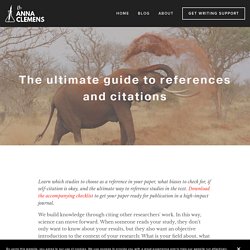
Download the accompanying checklist to get your paper ready for publication in a high-impact journal. We build knowledge through citing other researchers' work. In this way, science can move forward. When someone reads your study, they don’t only want to know about your results, but they also want an objective introduction to the context of your research: What is your field about, what are the issues and how do your findings relate to other studies? Although references to literature are crucial in scientific publishing, there seems to be little education about the topic. Behave With Sue - Episode One: Establishing your Expectations. Critical reading techniques: Active reading. Active reading simply means reading something with a determination to understand and evaluate it for its relevance to your needs.

Simply reading and re-reading the material isn't an effective way to understand and learn. Actively and critically engaging with the content can save you time. Publications – George Veletsianos, PhD. Books Veletsianos, G. (2020).

Learning Online: The Student Experience. Baltimore, MD: Johns Hopkins University Press. Veletsianos, G. (2016). Education, skills and work activities (Ofsted) Amanda Spielman launches Ofsted's Annual Report 2018/19. Ofsted's Chief Inspector Amanda Spielman discusses the quality of education, training and care services in England at the launch of Ofsted's Annual Report today (21 Jan).
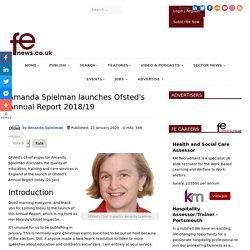
Introduction Good morning everyone, and thank you for coming today to the launch of this Annual Report, which is my third as Her Majesty’s Chief Inspector. It’s unusual for us to be publishing in January. This is normally a pre-Christmas event, but it had to be put on hold because of the election. Still, if anyone made a New Year’s resolution to listen to more speeches about education and children’s social care, I am entirely at your service. The election brought a lively political debate about the future of Ofsted. But even while Ofsted was in the uncomfortable position of being a political football, we were of course getting on with the day job, which means working firmly and unapologetically in the interests of children. AssessProgress - Adaptive Comparative Judgement. Racial Equity Tools. Home / Act / Strategies Training and Popular Education Overview Training and popular education are strategies intended to build individual’s and group’s capacity to understand structural racism, practice analyzing and applying, and build confidence and skills to act individually and collectively.
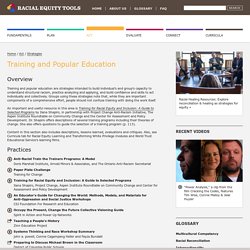
Groups using these strategies note that, while they are important components of a comprehensive effort, people should not confuse training with doing the work itself. Efficacy, explore, and exchange: Studies on social side of teacher education from England, Spain, and US. Anderson and Maninger, 2007 S.E.
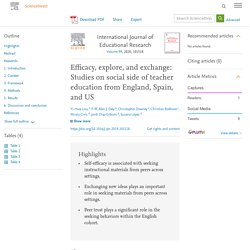
Anderson, R.M. ManingerPre-service teachers’ abilities, beliefs, and intentions regarding technology integration. Mad fun with the gang dem on @WILTY_TV tonight. Teachers and good hearted criminals, I’ve got your backs □□□… Policy Eye - highlights of week ending 13 December. Welcome to Policy Eye, a weekly service from Policy Watch offering a regular round-up of UK education headlines and stories from the previous seven days. The week summed up So now we know.
The general election result continues to be voluminously scrutinized with the word ‘historic’ being applied by many. Parliament will resume next week. For the moment, here’s the main education stories of the week with an eye on those issues that might face an incoming government. Higher education first where funding, the Augar review, international collaboration and the TEF continue to hang over the sector. A Connected Curriculum for Higher Education. The Periodic Table of #FE Educators on Twitter to follow today. Back in the summer, I was involved in a number of conversations about the creation of one of my periodic table designs, this time to highlight people to follow on Twitter from the FE sector. Teenage behaviour: 5 things teachers need to consider. Why do teens behave in ways that are sometimes utterly confusing to their teachers? Researchers can give us some strong clues. Studies have pinpointed adolescence as the period during which the human brain undertakes its final major construction project in the prefrontal cortex, the area of the brain through which the signals that underpin adult social behaviour flow.
Blakemore and Mills (2014) sum up how this is expressed in behaviour: Final session at #BERA2019 and a really valuable opportunity to discuss ethical dilemmas...… Great for CPD: Animation to illustrate what text looks like to someone with dyslexia. Evaluation of Tom Bennett Training Behaviour Management Programme - NFER. Background You, or staff in your school, are taking part in the Tom Bennett Training (TBT) Teaching and Leadership Innovation Fund (TLIF) Behaviour Management Programme. This project is funded by the Department for Education (DfE) through its Teaching and Leadership Innovation Fund (TLIF), a three-year investment programme, which supports high-quality professional development for teachers and school leaders in the areas and schools in England that need it most.
The programme aims to improve the outcomes of children and young people, thereby making a significant contribution towards tackling social mobility. The evaluation The National Foundation for Educational Research (NFER) and the Sheffield Institute of Education (SIoE) have been commissioned by the DfE to evaluate TLIF. Data we will collect. Made by an #autistic adult to explain difficulty in switching tasks/attention. #executivefunctioning… Films for Science Teachers - Alom Shaha. I have written, produced and directed a number of educational TV series, ranging in subject matter from a history of particle physics to key ideas covered in GCSE Science.
Below are a selection of videos I’ve developed and produced to help science teachers with the effective use of demonstrations and practical work as part of their lessons. Most of the films were made with my friend Jonathan Sanderson of StoryCog. Simple Convection Demo Demo films Simple Convection DemoDemo filmsThis is a cheap, elegant way to demonstrate convection which can be used with a “predict, observe, explain” approach when teaching.details How do we know what stars are made of?
T levels: distinction will have same Ucas points as 3As. Ucas has confirmed that a distinction at T level will be equivalent to three As at A level. The misallocation of students to academic sets in maths: A study of secondary schools in England - Connolly - 2019 - British Educational Research Journal. Introduction Whilst grouping students by attainment is a highly favoured practice in English secondary schools, it has attracted criticism in educational research (Oakes, 1985; Ireson & Hallam, 2001; Marks, 2012).
Howtoread. The role of leadership in prioritising and improving the quality of teaching and learning in further education. Presentation design & brain science - Overview.
Pedagogy focus: How has Jean Piaget influenced education? Who was Jean Piaget? Jean Piaget (1896-1980) was a Swiss psychologist, famous for his theories on child development. Cognitive Architecture and Instructional Design. Trialled and Tested: Working Memory - Evidence Based Education. A mental ill-health epidemic in #FE or something else entirely? PD North member Rebecca Gillett from Myerscough College shares her fascinating research into student mental-ill health. Thread by @EduCelebrity: "The basic parts of an book, a thread... 1. Boring story of how one became a teacher: One talks about how they were a terrible […]" #EduCelebrity.
My Resources - Reading for Pleasure and Progress. Presentations. Below you will find PowerPoint files for presentations given at conferences, workshops and other events. Inevitably, there is a lot of duplication. What Experienced Teachers can Learn from NQTs. Report calls for colleges to be put at the heart of lifelong learning. Colleges should be repositioned at the heart of a lifelong learning system for the 21st century, says the Transformative Teaching and Learning in Further Education report. Maximizing the Effectiveness of Multiple-Choice Qs. Below is a quick activity that is easily adaptable for most class settings. Trialled and Tested: Working Memory - Evidence Based Education. Whiteness resources and links. 2.2.05 FE or not FE. 1503 Salford Uni Report DIGITAL. Tes. Behaviour 101…A behaviour master class. Wilbrink (1997). Assessment in historical perspective. Studies in Educational Evaluation, 1997, 23, 31-48. pdf (Based on earlier work presented at Earli congress 1995 Nijmegen, a.o. paper) (intended to be the first part of my dissertation [in Dutch]: 1995 Leren waarderen SVO-project met notenapparaat) concept Ben Wilbrink abstract A historical perspective on assessment is presented, organized around seven themes, and located in the time window between the early middle ages and the end of the 19th century: ways of questioning, the graded school, medieval university examinations, the disputation, ranking and marking systems, examinations and personnel selection, and the possibly facilitating influence of Chinese mandarin examinations on the development of meritocratic assessment.
Assessment in historical perspective Historical study has the power to illuminate current assessment practice, because that practice is for the greater part traditional practice, and it is a powerful instrument to stimulate reflection on assessment. England. The role of leadership in prioritising and improving the quality of teaching and learning in further education. Teacherstakeaway. Subvertingthepseudo scienceofinspection pre print July2017. Inspecting education quality: lesson observation and workbook scrutiny.
The new education inspection framework (EIF) focuses on the quality of education more broadly. Therefore Ofsted needs to ensure that inspection methods are valid and reliable. Professor Daniel Muijs provides a commentary on the research and our next steps. This is the first report of a multi-phase research project. The report looks at the results of a recent pilot of workbook scrutiny indicators and rating scales. The research report focuses on 2 questions: Review of post 18 education and funding. Teaching and Learning International Survey (TALIS) - Overview. 19415257.2019. 1503 Salford Uni Report DIGITAL. Graduate outcomes (LEO): outcomes in 2016 to 2017. Consultation on Post-16 education - Education in the media.
How to get the Best out of Knowledge Organisers in your Classroom. Recommendations to maximise impact of Learning Support Assistants published - The Education and Training Foundation. 8 Good Resources to Help Students Develop Spelling Skills. Thread by @MaryCurnockCook: "I have to say, I'm loving the Augar Review. It's a terrific read (all 216 pages) - lots of insightful analysis (with historical context) and […]" #AugarReview. How to Use Gmail's Confidential Mode. Post-18 Review: AoC response. Using Google Jamboard on any Interactive Screen or device. 7 Plenary Activities for PGCE Students and Newly Qualified Teachers by @RichardJARogers. Cajkler and Wood 2016 to BJES final draft. Education and the Fourth Industrial Revolution (Video and Keynote Talk) Institute for Apprenticeships and Technical Education / Learning and skills teacher. Learning. Staff Retention Report – Edurio.
Formative & Summative Assessments. Journaling as a means to scaffold & assess learning. Characteristics of effective CPD – The halfbaked.education blog. Whose knowledge, whose culture? Re-thinking theory through restorative approaches. 16 19 Funding EPI 2019. Teaching Experience Report June 2016. Teaching and Learning Agenda 2019/20. My Best Lesson: Quantitative Chemistry.
Ten teaching techniques to practise – deliberately. Simplifying Cognitive Load Theory. Five Good Alternatives to YouTube for Finding Educational Videos. #rEdDXB @DavidDidau is fascinating in his talk on intelligence.… 13 Questions to ask to ensure you are an inclusive setting. – Inclusion, Education and Learning Resources. PCET placement forms - UWE Bristol: Department of Education and Childhood. 02602938.2019. Realising the potential of technology in education.
Welcome to the Scholarship Framework. Six New G Suite Features for Teachers and Students. CEBIS sur Twitter : "Let's demystify how you actually use: AND OR NOT with Duplo!! Join us for Session 4 of searching tips! @PubMedOnline @bmj_latest @CochraneUK @cochranecollab @tripdatabase @embase @WKHealthOvid @EBSCOUK @EBSCO @NICEcomms @NHSEngland @p.
Curriculum. Using #EdTech in your FE role? Have your say about how it should be used. Nothing new, it’s a review – on why I killed my starters.